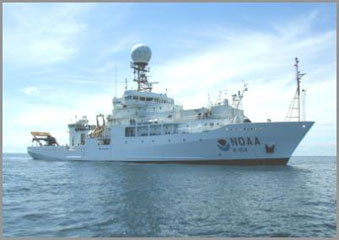R/V Ronald H. Brown Platform Info

NOAA's Marine Operations Center (MOC) outlines the operational capabilities and shipboard facilities of the NOAA Research Vessel Ronald H. Brown. The instrumentation (payload) capacity of Ronald H. Brown is not limited by weight or power constraints. Typically, atmospheric sampling instruments are placed in seagoing laboratories (sea-tainers) on the forward upper (02) deck. Air samples are collected using towers or masts that extend 6-8 meters above the deck (approximately 16 - 18 meters above the water line). Sampling is conducted around the clock, unless contamination from the ship exhaust is expected to be prolonged. Remote sensing meteorological measurements are also included in the instrument package to define the structure and extent of the MBL and thus place the chemical measurements in context. Augmentation of the on-board radar wind profiler with additional lidar instruments is critical for this activity. This ship is one of the ICARTT 2004 Mobile Platform sites.
| Parameter | Specification |
| Length (ft/m) | 274 / 83.5 |
| Range (nm/km) | 11,300 / 20,900 |
| Endurance (days) | 35 |
| Cruising speed (kts / mps) | 12 / 6.2 |
| Maximum speed (kts / mps) | 15 / 7.7 |
| Officers / Engineers / Crew | 5 / 4 / 16 |
| Scientific staff | 34 (maximum) |
| Laboratory/office space (sq. ft.) | 4100 |
| Telecommunications, data | INMARSAT-A |
| Telecommunications, voice | Cell & satellite phones, VHF radios |
The ship is capable of staying out to sea for long periods, which allows for repeated sampling of air masses in a particular region, such as the Gulf of Maine. However, with an average cruising speed of 12 knots the ship is not a rapidly moving platform. For example, at the nominal cruise speed (22 km hr-1) the 400 km trip from Boston, MA, to Yarmouth, NS, takes 18 hours. Within certain constraints NOAA R/V Ronald H. Brown is capable of extended near-shore running, which is especially valuable for examination of pollution plumes advected off the shore and for examination of meteorological phenomena such as land-sea breeze effects. The ship is fully capable of nighttime operations, though with some restrictions when near shore.

